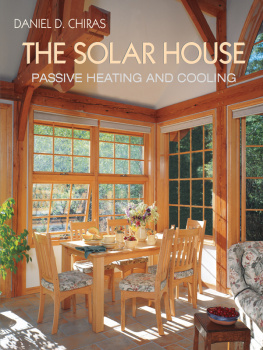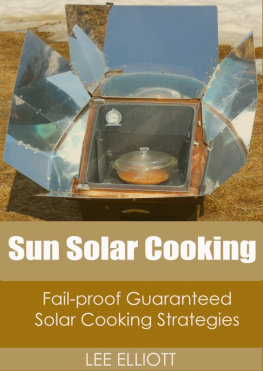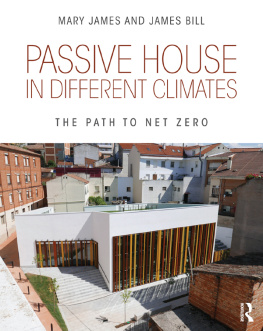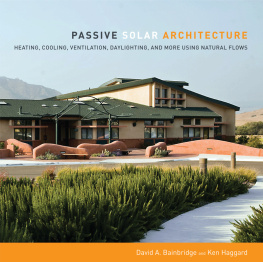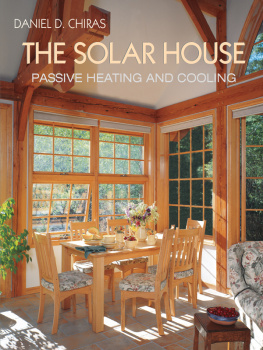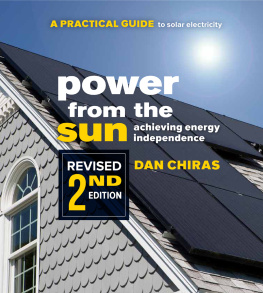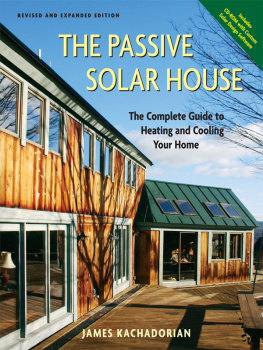Copyright 2002 Daniel D. Chiras.
Unless otherwise noted, photographs copyright 2002 Daniel D. Chiras.
Unless otherwise noted, illustrations copyright 2002 David Smith.
Designed by Jill Shaffer.
All rights reserved. No part of this book may be transmitted in any form by any means without permission in writing from the publisher.
Printed in Canada.
First printing, October 2002.
Printed on acid-free, recycled paper.
Due to the variability of local conditions; materials; skills; site; the complexity of building a home in general and a passively conditioned structure specifically; and so forth, Chelsea Green Publishing Company and the author assume no responsibility for personal injury, property damage, or loss from actions inspired by information in this book. Always consult manufacturers of specific products, applicable local and state laws, and the National Electric Code. When in doubt, ask for advice. Opinions expressed in this book are based on the authors personal experience.
Many of the designations used by manufacturers and sellers to distinguish their products are claimed as trademarks. Where those designations appear in this book and Chelsea Green was aware of a trademark claim, the designations have been printed in initial capital letters.
SELECTED TITLES BY THE AUTHOR
The Natural House: A Complete Guide to Healthy, Energy-Efficient,Environmental Homes (Chelsea Green)
The Natural Plaster Book: Earth, Lime, and Gypsum Plastersfor Natural Homes (New Society Publishers)
Lessons From Nature: Learning to Live Sustainably on the Earth (Island Press)
Beyond the Fray: Reshaping Americas Environmental Movement (Johnson Books)
Voices for the Earth: Vital Ideas from Americas Best Environmental Books (Johnson Books)
Environmental Science: Creating a Sustainable Future, 6th ed. (Jones and Bartlett)
Natural Resource Conservation: Management for a Sustainable Future, 8th ed. (Prentice Hall)
Human Biology: Health, Homeostasis, and the Environment, 4th ed. (Jones and Bartlett)
Biology: The Web of Life (West)
Study Skills for Science Students (Brookes-Cole)
Essential Study Skills (Brookes-Cole)
DEDICATION
To Linda, my love
TABLE OF CONTENTS
A GREAT MANY PEOPLE have aided me in the preparation of this book. I am deeply indebted to those who answered my frequent questions and provided additional information to help create a comprehensive and accurate book on passive heating and cooling, including Ron Judkoff and Chuck Kutscher (NREL), Doug Hargrave (SBIC), Alex Wilson (BuildingGreen), Bill Eckert (Friendly Fire), Niko Horster (Chelsea Green), Bruce Brownell (Adirondak Alternate Energy), Heinz Flurer (Biofire), Vashek Berka (Bohemia International), Randy Udall (CORE), James Plagmann (HumanNature), David Adamson (EcoBuild), and Professor Murray Milne (UCLA). Many thanks to the dozens of individuals and companies who provided photos for use in this book.
I am especially thankful to those who read early drafts of the manuscript, offering insightful comments and vital corrections: Niko Horster, Jim Schley, Ron Judkoff, and Bill Eckert. Your assistance was invaluable! I also owe a debt of gratitude to the folks at Chelsea Green, including my editors Jim Schley and Alan Berolzheimer for helping me shape and refine this book and to my illustrator, David Smith, for his fine contributions to this project.
Finally, on a personal level, many thanks to my two darling sons, Forrest and Skyler, for being themselvesinsightful, funny, joyful, hard-working, and responsibleand to my partner, Linda, for her patience, understanding, kindness, and unwavering love and support.
A FEW YEARS AGO, a friend of mine called and asked if I would give my opinion on a home she was considering buying. The house in question was a passive solar designthat is, a home that is heated by the sun directly through south-facing windows. I was living in a passive solar home at the time (see ) and had been studying such designs for twenty years, so I agreed to go along to assess the structure.
The next morning we headed out to take a look at the house, located down a twisty gravel road about half an hour from my home in the foothills of the Rockies. It was a picture-perfect fall day, a great time for evaluating a solar home.
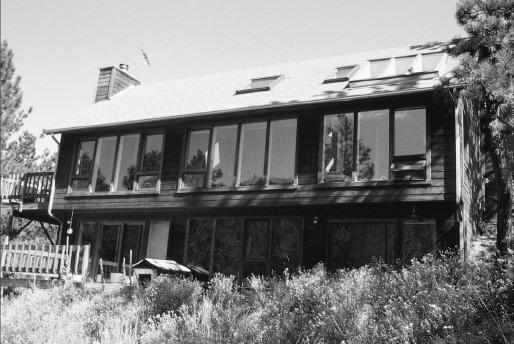
FIGURE I-1
The authors first passive solarhouse offered numerous solarfeatures, including a thermalstorage wall (bottom center),attached sunspace (bottomleft), and direct-gain solar (theremainder of the solar glazing).One of the flaws of the designwas overglazing: too manywindows and skylights inrelation to thermal mass. Thehouse tended to overheat yearround. Summertime heat gainwas especially troublesomebecause of the numerousskylights and west-facingsliding glass doors (not shown).

FIGURE I-2
Trombe walls are one typeof solar design used in homes.This diagram shows howthey work.
As we drove up the driveway, my first impression was quite favorable. The house was compactly designed, attractive, and located on an extremely nice lot with a spectacular view of Mount Evans, a 14,000-foot peak.
As we stepped out of the car, the main solar feature came into view: a huge thermal storage wall, known as a Trombe wall. Described in more detail in chapter 3, a Trombe wall is typically located on the south side of a home, constructed from concrete block, and covered by glass. Low-angled winter sunlight penetrating the glass heats the wall, and the heat is gradually released into the home (figure I-2). (It moves inward by conduction, flowing from warm to cold, as heat always does.)
We looked around inside, talked with the owners, then toured the barn and walked the property. After looking over the house a second time with my enthusiasm growing, the owner made a statement that sent up a red flag. He mentioned in passing that after waking that morning, he had needed to start a fire in the wood stove to warm up the house. The interior temperature, he told us, had dropped into the low 60s during the night. In fact, he went on to say, he had to heat the home every morning during the heating season, which here consisted of the fall, winter, and much of the spring.
This seemed rather odd to meall the more peculiar because we were experiencing some rather unseasonably warm and sunny weather. Moreover, in my own passive solar home we hadnt needed any back-up heat that year.

